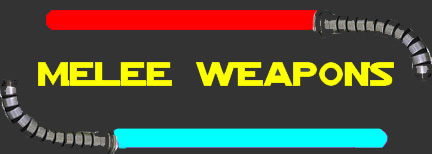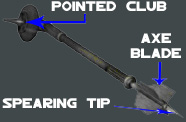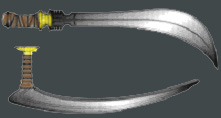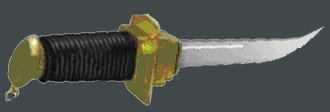Blaster Theory
Blasters
Slugthrowers
Grenades
Melee Weapons
Other Weapons
Course Exam

Melee weapons are the oldest tools in the galaxy, dating back before recorded history to the first time a primitive being picked up a sharp rock or small tree and used it to club/skewer/bludgeon something for dinner, or for self defense. Modern melee weapons carry on that tradition. While all melee weapons presented here are implements of war, some still retain utilitarian applications such as skinning game and felling trees.
Although the blaster is undeniably 'king of the battlefield', melee weapons have an important role in the galaxy. Some worlds prohibit possession or sale of ranged weapons, yet allow melee weapons to flourish, which they often do as a viable alternative to the blaster or slugthrower. Melee weapons are generally much cheaper and easier to conceal than blasters, making them the weapon of choice for most galactic denizens. Melee weapons are much quieter than blasters or slugthrowers, some are even silent, allowing assassins or commandoes to employ them with perfect stealth. On many Outer Rim worlds, blasters and their parts are in short supply, making melee weapons the defacto standard of the local population.
When battlefield ranges drop to zero, a good melee weapon is often preferable to a blaster when engaging in close quarters combat. This provides a last defense to troopers against a charging or hidden enemy force. Despite the ranged nature of modern warfare, hand-to-hand combat is still a battlefield reality and must be prepared for even more stringently than ranged combat, as more skill is generally required to effectively wield melee weapons.
Some cultures place great significance in the crafting and use of melee weapons. Wookiees, Tusken Raiders, and Rodians all consider their unique weapons to be symbols of honor and all are highly trained in their use. In each culture, stories abound of legendary weapons with mystical powers. Imperial archaeologists and historians have found no proof of such abilities and therefore discount such claims as the archaic beliefs of primitive cultures.
Melee weapons are generally separated into two categories: powered and unpowered. Unpowered weapons rely upon the wielder's strength to inflict damage. Unpowered weapons are generally more difficult to detect via scans due to their lack of power cells commonly found in modern blasters and powered melee devices such as vibroblades. The powered versions have a generator or power cell of some kind as the primary means of causing damage. Both types are discussed below with examples given.
COMMON MELEE WEAPONS
 The Combat Knife has changed very little through the
countless millennia of its use. Other than adapting to
changes in metallurgy, a combat knife of today is very similar to
those found even before the discovery of hyperspace travel.
Its simple single-blade design is designed for slashing or
stabbing and retains a sharp edge for years with only minimal
maintenance.
The Combat Knife has changed very little through the
countless millennia of its use. Other than adapting to
changes in metallurgy, a combat knife of today is very similar to
those found even before the discovery of hyperspace travel.
Its simple single-blade design is designed for slashing or
stabbing and retains a sharp edge for years with only minimal
maintenance.
The combat knife is unpowered and is the shortest and most basic melee weapon presented in this course. Blade length is typically no more than 20 centimeters. The combat knife is easily concealable, difficult to detect, and utterly silent. This last aspect is very appealing to commandos who utilize the combat knife to silently eliminate sentries around enemy installations or encampments. The knife is ineffective against modern armor, but easily slips between the gaps of the armored plates. Storm Commandos train regularly with this weapon due to the precise strikes required for quick silent kills.
Some blaster rifles are equipped with mounting rings to accommodate a knife under the muzzle, effectively turning the combat knife into a bayonet. While the command to 'Fix Bayonets' is usually the final order of a doomed infantry unit, the weapon does offer troops a final chance to go down fighting when resisting or making a charge, rather than simply surrendering to the enemy. When engaging in hand-to-hand combat, it is preferable to use the combat knife individually rather than as a bayonet. Holding the knife in one's hand gives the wielder many more options than the simple stabbing technique of the bayonet.
Standard issue for all Emperor's Hammer combat personnel, the combat knife is not only handy in a fight, but is also a useful survival tool. With it, a soldier can clean game, clear brush, open containers, or create shelter. Never be without it!
 The Gaderffii or "Gaffi Stick" is the traditional
melee weapon of Tatooine's Tusken Raiders. These short
polearms can kill at either end: one sports a multi-bladed axe and
spearing tip, while the other ends in a pointed club for bludgeoning
and impaling opponents. The nomadic Sand People do not have
access to modern blasters or other advanced technology, so the
gaderffii is their primary weapon. While plastoid armor is
impervious to the gaderfii's axe blades, the spearing tip could
easily penetrate between the armor's plates or the club could be
used to knock a Stormtrooper off balance.
The Gaderffii or "Gaffi Stick" is the traditional
melee weapon of Tatooine's Tusken Raiders. These short
polearms can kill at either end: one sports a multi-bladed axe and
spearing tip, while the other ends in a pointed club for bludgeoning
and impaling opponents. The nomadic Sand People do not have
access to modern blasters or other advanced technology, so the
gaderffii is their primary weapon. While plastoid armor is
impervious to the gaderfii's axe blades, the spearing tip could
easily penetrate between the armor's plates or the club could be
used to knock a Stormtrooper off balance.
Tusken warriors hand craft each gaderffii and are highly skilled in its use. Larger, more deadly gaderffii belong to chieftains or ranking warriors in each clan who use their weapons to intimidate others in order to gain social standing. Such opponents are deadly, even to Stomtrooper units. Exercise caution around such individuals.
Gaderffii have a number of utilitarian uses as well. From marking territorial boundaries and unearthing roots, to serving as simple walking sticks in the deep desert's uneven terrain, these simple yet deadly weapons exemplify their masters harsh way of life.
 Long before the Wookiees adopted ranged weapons, Ryyk blades
were their primary means of hunting and protection. The weapon
design is simple, consisting of a single blade attached to a
hide-bound wooden handle, but in the hands of a Wookiee warrior
these cutting implements are deadly. Wookiees wield them with
such force that despite the weapon's primitive unpowered nature, a
single strike can cleave an armored Stormtrooper in two. Any
Stormtrooper lucky enough to have survived the occupation of
Kashyyyk can attest to this weapon's deadly power.
Long before the Wookiees adopted ranged weapons, Ryyk blades
were their primary means of hunting and protection. The weapon
design is simple, consisting of a single blade attached to a
hide-bound wooden handle, but in the hands of a Wookiee warrior
these cutting implements are deadly. Wookiees wield them with
such force that despite the weapon's primitive unpowered nature, a
single strike can cleave an armored Stormtrooper in two. Any
Stormtrooper lucky enough to have survived the occupation of
Kashyyyk can attest to this weapon's deadly power.
Wookiees handcraft their individual Ryyk blades in elaborate ceremonies, and train relentlessly in their use. Wookiee culture sees the warrior as an extension of the blade, and the graceful dance of death performed with these blades is both beautiful and frightening to behold. Great importance is placed upon the blade, which is seen as an extension of the Wookiee warrior's honor. To lose a Ryyk blade is to bring great dishonor upon the unfortunate Wookiee's family.
The Ryyk blade is too large and heavy for smaller species to effectively wield, making this balanced weapon a feared addition to the Wookiee arsenal. Many are adorned with personal ornamentation and runes denoting valor in combat or victory over powerful foes. Pictured at right are two of the many different Ryyk designs. The first is a traditional scimitar best suited for powerful overhand strikes, while the second, with its 90 degree offset handle, is wielded "hilt first" in arcing sweeps meant to decapitate or eviscerate foes.
 Vibroblades are powered melee weapons equipped with a power cell and
a high intensity sound generator in the hilt. When activated,
the generator creates thousands of ultrasonic pulses per second
sending, vibrations down the blade's edge. This enables the
weapon to cut through many materials with the slightest touch.
Vibroblades are common in most parts of the galaxy, including many
areas where blasters are prohibited, so vibroblades are frequently
encountered by Stormtroopers. Exercise caution when faced with
any vibroweapon as the blade's enhanced cutting power can easily
slice through plastoid armor.
Vibroblades are powered melee weapons equipped with a power cell and
a high intensity sound generator in the hilt. When activated,
the generator creates thousands of ultrasonic pulses per second
sending, vibrations down the blade's edge. This enables the
weapon to cut through many materials with the slightest touch.
Vibroblades are common in most parts of the galaxy, including many
areas where blasters are prohibited, so vibroblades are frequently
encountered by Stormtroopers. Exercise caution when faced with
any vibroweapon as the blade's enhanced cutting power can easily
slice through plastoid armor.
Vibroblades are issued to Hammer's Fist personnel as part of a standard kit. These weapons are more versatile and deadly than a combat knife, but are only slightly larger in size. Vibroweapons are characterized by their distinctive worr-pitched humming sound when in operation. This noise carries a short distance, but is loud enough to make vibroblades unsuitable for covert operations.
All vibroweapons conduct electricity and are unsuitable for use against electrical weapons or around areas of intense electrical activity. If struck with an electrical discharge, electrocution is the least of a vibroblade wielder's concerns as the shock will cause the generator to overload, exploding the vibroblade's power cell, and likely amputating the user's hand.
 Vibroswords are merely a larger version of the
common vibroblade. These weapons see mostly ceremonial use
among ancient military orders, but are quite effective in
combat. Blade length is typically 1 meter. Due to its
size and weight, the vibrosword is typically wielded with two
hands, although larger species manage these weapons
single-handedly.
Vibroswords are merely a larger version of the
common vibroblade. These weapons see mostly ceremonial use
among ancient military orders, but are quite effective in
combat. Blade length is typically 1 meter. Due to its
size and weight, the vibrosword is typically wielded with two
hands, although larger species manage these weapons
single-handedly.
 The Sorosuub BD-1 "Cutter" Vibroaxe is a
large weapon commonly found among the galaxy's underworld
enforcers and guards. The 2 meter length provides greatly
extended reach to this, the largest and most damaging vibroweapon.
The hollow shaft reduces weight and contains dampeners to reduce
residual vibrations. The axe head is detachable via two
quick-release clamps, allowing for rapid repair of a damaged
blade.
The Sorosuub BD-1 "Cutter" Vibroaxe is a
large weapon commonly found among the galaxy's underworld
enforcers and guards. The 2 meter length provides greatly
extended reach to this, the largest and most damaging vibroweapon.
The hollow shaft reduces weight and contains dampeners to reduce
residual vibrations. The axe head is detachable via two
quick-release clamps, allowing for rapid repair of a damaged
blade.
 The Force Pike is used by law enforcement and security personnel as
an effective implement of crowd control. The 1.5 meter weapon
is tipped with a vibro-edged head containing a stun module capable
of rendering an Wookiee unconscious. The impulses generated by
the stun module overload the recipient's central nervous system,
similar to a blaster rifle's stun setting. The vibrohead is
capable of shredding bulkheads and beings alike, making the Force
Pike the preferred weapon for starship boarding actions.
The Force Pike is used by law enforcement and security personnel as
an effective implement of crowd control. The 1.5 meter weapon
is tipped with a vibro-edged head containing a stun module capable
of rendering an Wookiee unconscious. The impulses generated by
the stun module overload the recipient's central nervous system,
similar to a blaster rifle's stun setting. The vibrohead is
capable of shredding bulkheads and beings alike, making the Force
Pike the preferred weapon for starship boarding actions.
The Sorosuub Controller Force Pike pictured at right was the favored melee weapon of the Imperial Royal Guard. Often viewed by outsiders as ceremonial in nature, the Royal Guardsmen employed their force pikes with great effect when called upon to do the Emperor's bidding.
 Electrostaffs were famously carried by droid
MagnaGuards during the Clone Wars. Constructed of
lightsaber-resistant phrik metal and tipped on each end with
electropulse generators. The 2 meter weapons provided the
droids with a significant reach advantage and the variable-setting
pulse generators could deliver anything from an incapacitating
jolt to a fatal shock. MagnaGuards wielded the Electrostaff
with deadly efficiency, as many Jedi discovered shortly before
their demise.
Electrostaffs were famously carried by droid
MagnaGuards during the Clone Wars. Constructed of
lightsaber-resistant phrik metal and tipped on each end with
electropulse generators. The 2 meter weapons provided the
droids with a significant reach advantage and the variable-setting
pulse generators could deliver anything from an incapacitating
jolt to a fatal shock. MagnaGuards wielded the Electrostaff
with deadly efficiency, as many Jedi discovered shortly before
their demise.
 Lightsabers are rare, unique, and the most devastating melee weapons
in the galaxy. These elegant weapons are the hallmark of Force
users everywhere, who wield them with deadly efficiency. The
massless blade makes the weapon extremely difficult to use
effectively and poses a great danger to anyone untrained in its
use. Never attempt to use a lightsaber without first receiving
extensive training, as death or serious injury are likely to occur.
Lightsabers are rare, unique, and the most devastating melee weapons
in the galaxy. These elegant weapons are the hallmark of Force
users everywhere, who wield them with deadly efficiency. The
massless blade makes the weapon extremely difficult to use
effectively and poses a great danger to anyone untrained in its
use. Never attempt to use a lightsaber without first receiving
extensive training, as death or serious injury are likely to occur.
Many varieties of lightsabers exist, however the two most commonly encountered are pictured at right. First is the traditional single-bladed 'saber. The blue beam is usually indicative of a Jedi owner as they tend to create their weapons with blue or green blades. Second is the double-bladed 'saber, which generates a beam from each end. This is a far more dangerous weapon, both for the wielder and anyone unfortunate enough to oppose them, and is thus more rarely encountered.
The lightsaber hilt generates an arc of pure energy, capable of cutting through virtually any known substance. Only rare ores such as cortosis and phrik along with special alloys like Mandalorian Iron and Sith Steel are capable of resisting a lightsaber's deadly blade. Energy shields are likewise impenetrable to a lightsaber, offering a more affordable and readily available countermeasure.
Countering Lightsabers:
 No matter what method is employed, concentrated fire is the key
to overwhelming an opponent using a lightsaber. Exercise
extreme caution when engaging anyone wielding a lightsaber.
Blasters are largely ineffective as most Jedi are capable of
parrying the bolts. Advanced Force users are even capable of
reflecting the bolts back at the shooter! Stun bolts are more
effective, as the Jedi cannot block them, but Force users possess
special powers to resist the effects of a stun blast.
Slugthrowers and railguns are the preferred means of engaging a Jedi
with handheld weapons as the projectiles are much smaller and travel
many times faster than blaster bolts, making them difficult to
parry. In addition, the physical projectiles vaporize on
contact with the lightsaber blade, making it impossible for the Jedi
to reflect them at the shooter.
No matter what method is employed, concentrated fire is the key
to overwhelming an opponent using a lightsaber. Exercise
extreme caution when engaging anyone wielding a lightsaber.
Blasters are largely ineffective as most Jedi are capable of
parrying the bolts. Advanced Force users are even capable of
reflecting the bolts back at the shooter! Stun bolts are more
effective, as the Jedi cannot block them, but Force users possess
special powers to resist the effects of a stun blast.
Slugthrowers and railguns are the preferred means of engaging a Jedi
with handheld weapons as the projectiles are much smaller and travel
many times faster than blaster bolts, making them difficult to
parry. In addition, the physical projectiles vaporize on
contact with the lightsaber blade, making it impossible for the Jedi
to reflect them at the shooter.
Grenades or other area-effect weapons are more effective against Jedi as they cannot parry and have difficulty dodging the blast radius. Take care that any grenades hurled against Jedi opponents are not released too early as the Jedi can easily hurl even multiple grenades back toward the throwing troops.
Never under any circumstance engage a Jedi in melee combat. Their lightsabers can slice through any standard issue melee weapons. Retreat, followed by artillery barrages, air strikes, or orbital bombardment of the area are all advisable tactics in this situation.